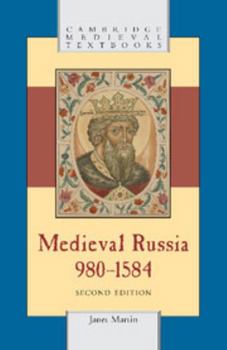Medieval Russia, 980-1584
Select Format
Select Condition 
Book Overview
This revised edition is a concise, yet comprehensive narrative of the history of Russia from the reign of Vladimir I the Saint, through to the reign of Ivan IV the Terrible. Supplementing the original edition with results of recently published scholarship as well as her own research, Janet Martin emphasizes the dynamics of Russia's political evolution from the loose federation of principalities known as Kievan Rus' through the era of Mongol domination to the development of the Muscovite state. Her analyses of the ruling dynasty, of economic influences on political development, and her explorations of society, foreign relations, religion, and culture provide a basis for understanding the transformations of the lands of Rus'. Her lines of argument are clear and coherent; her conclusions and interpretations are provocative. The result is an informative, accessible, up-to-date account that will be of interest to both students and specialists of early Rus'.
Format:Paperback
Language:English
ISBN:0521676363
ISBN13:9780521676366
Release Date:January 2008
Publisher:Cambridge University Press
Length:540 Pages
Weight:1.65 lbs.
Dimensions:1.3" x 5.4" x 8.5"
Customer Reviews
1 rating
A nice introduction to Medieval Russia
Published by Thriftbooks.com User , 15 years ago
I actually have delayed writing a review for this book for about a year now. This book (2nd ed., 2008) was assigned for a Russian history class I was taking and, as a political, social, and economic textbook, it provided a nice narrative of Russian history dating from the adoption of Christianity (988) until the reign of Ivan the Terrible. Martin's book, as one reviewer has correctly noted, does start off from an odd year: ca. 980 AD. This was around the time that a Russian prince named Vladimir had secured his position on the Russian throne following a succession crisis. To most readers who are unfamiliar with the topic, this event comes off rather abruptly, and considering that the first historical figures that we can identify in Russian history date to the early ninth century, it certainly would have been better for Martin to have started her narrative from there (or at least presented a prologue on what was taking place in Russia up until that time). Nevertheless, the book is highly informative and erudite from this point forward, as we learn about Vladimir's successors, the princely succession system, cultural and social life in Kievan Rus, the Mongol invasions and its collapse, and the consolidation of the Russian states and subsequent rise of Muscovy. Certain reviewers have complained that the book is not written well, although I would like to add some caveats of my own. While the book may not be a page-turner for everyone, Martin's writing style and prose is not as drab and bland as they make it out to be. The reader will indeed encounter many names and places and this may overwhelm one; however, there are some useful maps and several family-tree diagrams of the reigning princes and monarchs. The text is accompanied by numerous footnotes and the book includes an extensive bibliography. While it may not be perfect for some, readers who are interested in learning more about medieval Russian history will definitely profit from Martin's work.





